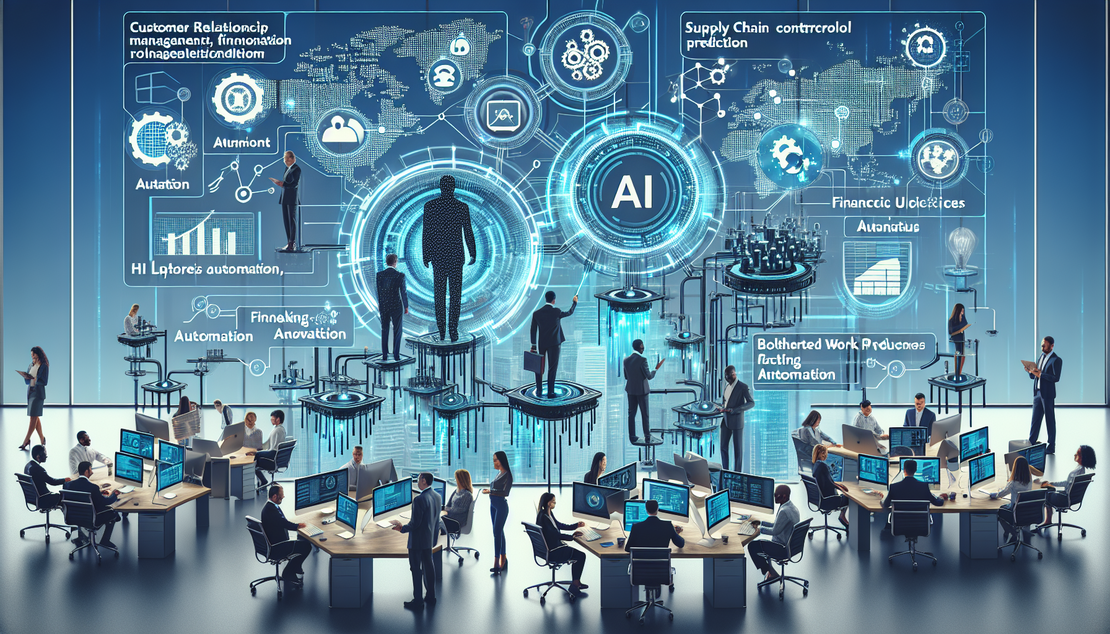
The Future of AI-driven Business Automation: Trends and Predictions for 2023
- Rajdeep Barad
- Ai driven business automation , Ai predictions , Ai trends , Future of business automation
- February 16, 2025
The Future of AI-driven Business Automation: Trends and Predictions for 2023
The Growing Importance of AI-driven Business Automation
Artificial Intelligence (AI) is revolutionizing the way businesses operate in today’s digital age. Let’s explore how AI-driven business automation is becoming increasingly vital for companies to stay competitive.
- AI transforms traditional business models
Pro Tip: Embrace AI to rethink your business model. By leveraging AI, businesses can discover new revenue streams and enhance operational efficiency.
- Increasing efficiency and productivity with automation
Pro Tip: Identify repetitive tasks that can be automated. Streamlining processes through AI not only boosts productivity but also allows employees to focus on more strategic tasks.
- Enhancing decision-making processes with AI
Pro Tip: Utilize AI-driven analytics for data-driven decision-making. AI algorithms can analyze vast amounts of data in real-time, providing valuable insights for informed decision-making.
- Improving customer experience through automation
Pro Tip: Implement AI-powered chatbots for personalized customer interactions. Automation in customer service not only enhances user experience but also reduces response times.
- Reducing operational costs and errors
Pro Tip: Use AI for predictive maintenance to reduce downtime. AI can predict equipment failures before they occur, helping businesses save on maintenance costs and prevent disruptions.
Current Trends in AI-driven Business Automation
Stay ahead of the curve by exploring the latest trends in AI-driven business automation that are shaping industries worldwide.
- Rise of chatbots and virtual assistants
Pro Tip: Integrate AI chatbots across customer touchpoints for seamless interactions. Chatbots can provide instant support, guide purchasing decisions, and even collect feedback.
- Integration of machine learning for predictive analytics
Pro Tip: Implement machine learning algorithms for accurate demand forecasting. By analyzing historical data, businesses can optimize inventory management and improve resource allocation.
- Expansion of robotic process automation (RPA)
Pro Tip: Automate rule-based tasks with RPA for increased efficiency. RPA allows companies to automate repetitive processes, reduce manual errors, and enhance overall productivity.
- Personalization through AI-driven recommendations
Pro Tip: Leverage AI for personalized marketing strategies. By analyzing user behavior and preferences, businesses can deliver tailored recommendations and drive higher conversion rates.
- Automation of repetitive tasks in various industries
Pro Tip: Explore industry-specific automation solutions for enhanced operations. Customized automation tools can streamline processes in sectors such as finance, healthcare, and manufacturing.
Key Predictions for AI-driven Business Automation in 2023
Get ready for the future with these key predictions outlining the role of AI-driven automation in various business domains.
- Growth of AI in cybersecurity for threat detection
Pro Tip: Invest in AI-powered cybersecurity solutions to proactively mitigate cyber threats. AI algorithms can detect anomalies and potential security breaches, enhancing overall data protection.
- Increased utilization of AI in healthcare for diagnostics
Pro Tip: Embrace AI for medical image analysis and diagnosis. AI technologies can assist healthcare professionals in interpreting complex medical images and improving patient outcomes.
- Expansion of AI-powered supply chain management
Pro Tip: Optimize supply chain operations with AI-driven forecasting. AI can analyze supply and demand patterns, enhance inventory management, and streamline the entire supply chain process.
- Implementation of AI in marketing for targeted campaigns
Pro Tip: Leverage AI for personalized marketing campaigns. By segmenting target audiences and analyzing campaign performance, businesses can achieve higher engagement and conversion rates.
- Rise of AI-powered decision-making tools for businesses
Pro Tip: Utilize AI for data-driven decision support. AI tools can process complex data sets, identify trends, and provide insights for more effective strategic decision-making.
Challenges and Opportunities in Adopting AI-driven Automation
While the benefits of AI-driven automation are vast, businesses also face challenges when integrating these technologies into their operations.
- Data privacy and security concerns
Pro Tip: Prioritize data security measures when implementing AI systems. Encryption, access controls, and regular security audits are essential to protect sensitive business data.
- Skilled talent shortage in AI and automation
Pro Tip: Invest in employee training and development programs. By upskilling existing talent and hiring AI experts, businesses can bridge the talent gap and foster a culture of innovation.
- Integration issues with existing systems
Pro Tip: Conduct a thorough system assessment before AI implementation. Compatibility testing and seamless integration between AI tools and existing systems are vital for successful automation deployment.
- Opportunities for innovation and competitive advantage
Pro Tip: Embrace AI as a catalyst for innovation. Companies that leverage AI-driven automation can gain a competitive edge, drive new product development, and enhance customer experiences.
- Need for proper training and upskilling of employees
Pro Tip: Offer continuous training programs to build AI proficiency among employees. By creating a learning culture and providing resources for skill development, businesses can maximize the benefits of AI technologies.
The Future Landscape of AI-driven Business Automation
As AI technologies continue to advance, the future landscape of AI-driven business automation presents both challenges and opportunities for organizations.
- Impact of AI on job roles and workforce dynamics
Pro Tip: Redefine job roles to align with AI integration. Upskill employees for roles that complement AI capabilities, leading to a more efficient and adaptive workforce.
- Potential for new business models and revenue streams
Pro Tip: Explore AI-driven business model innovations. By identifying new revenue streams and leveraging AI for product customization, businesses can unlock growth opportunities in dynamic markets.
- Ethical considerations in AI-driven decision-making
Pro Tip: Establish ethical guidelines for AI use within your organization. Transparency, fairness, and accountability are crucial pillars for ethical AI decision-making and building trust with customers.
- Emergence of AI regulation and compliance standards
Pro Tip: Stay informed about evolving AI regulations and standards. Compliance with data protection laws, ethical AI frameworks, and industry-specific regulations is essential for sustainable AI adoption.
- Continuous evolution of AI technologies and applications
Pro Tip: Stay updated on the latest AI trends and advancements. Continuous learning and adaptation to new AI technologies will position businesses at the forefront of innovation and competitive advantage.
Ready to transform your digital vision?
Get in touch with us to explore how our cutting-edge solutions can elevate your business to new heights. Contact us today!
Get in Touch


